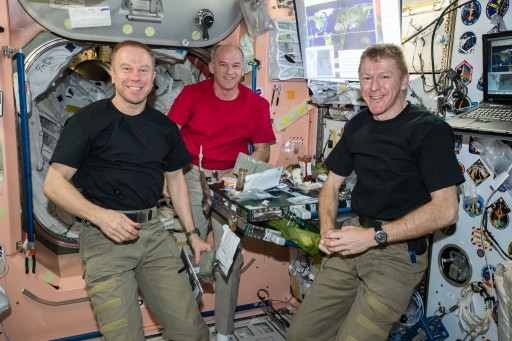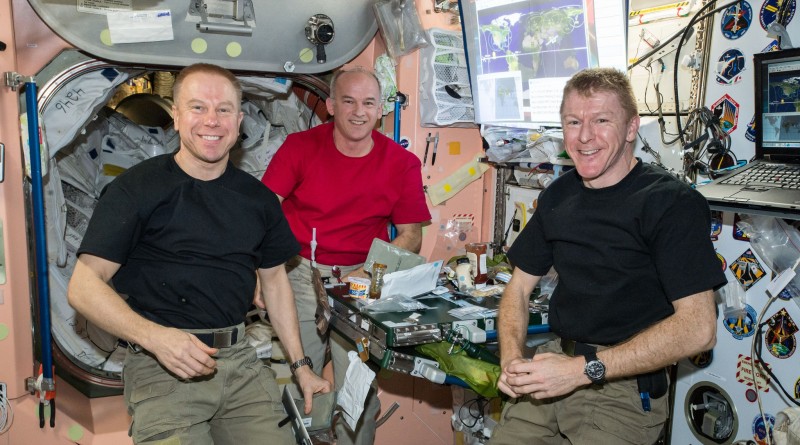ISS Operations Update – April 26, 2016

Common Communications for Visiting Vehicles – Checkout Day:
The C2V2 radio and antenna architecture was established at ISS over the past year via the installation of external antenna units and associated cables in several spacewalks and internal radio units and processing systems put in place in March. Checkouts are completed as part of a two-week campaign.
On Monday, a radio pass over a ground station was performed during which fill frames were successfully transmitted through the C2V2 system. This test provided confirmation that the forward and aft antennas are functioning as planned.
As part of the second test day on Tuesday, C2V2-A was used to send commands and GPS data to the Electronic System Test Laboratory (ESTL) on the forward link. C2V2-A also transmitted GPS Auxiliary Data, Audio and Broadcast Auxiliary Data with good comm checks noted between Capcom and the Electronic System Test Laboratory.
Experiments:
Rodent Research 3 – Access unit inspection & re-stocking [Rodent Research 3, named after the sponsoring company Eli Lilly and Co., will conduct a close study of myostatin inhibition for the prevention of sekeletal muscle atrophy and weakness in mice during long-duration spaceflight. A rapid loss of bone and muscle mass is observed in astronauts during spaceflight, especially to the legs and spine at rates similar to atrophy in people with muscle-wasting deseases on Earth. The study makes use of mice as a model organism to examine the response to certain drugs preventing muscle or bone loss.]
Fluid Shifts – Baseline Measurements [Fluid Shifts Before, During and After Prolonged Space Flight and Their Association with Intracranial Pressure and Visual Impairment. Known as the Fluids Shift study, this experiment is one of the most complex integrated experiments ever performed on ISS using pieces of US and Russian hardware to attempt to quantify the amount of fluid shifting from the lower body to the upper body when transitioning from a gravity to a microgravity environment. This will also lead to an understanding of effects of the fluid shift on fluid pressure in the head, changes to vision and eye structure. Effects on the eye caused by elevated intracranial pressure include globe flattening, choroidal folds, and alteration of the optic nerve.]
Habitability Experiment Ops [Assessment of International Space Station Vehicle Habitability will see teams on the ground study video of the behavior of crew members within the habitable environment of ISS while the crew fills out questionnaires and collects video of areas of interest in order to provide an assessment of the habitability of ISS in its current state for a one-year mission. Results will be used to develop spacecraft with improved habitability properties to allow crew members to optimally utilize the onboard space.]
Wet Lab RNA SmartCycler Experiment Session [The Wetlab RNA SmartCycler provides real-time quantitative gene expression analysis aboard ISS, enabling genomic studies in the unique space environment.]
Vzir Experiment Operations and Tagup [Vzir (Viewfinder) uses the SKPF-U (Photo Image Coordinate Reference System) hardware, a photo image coordinate reference system using ultrasound sensors and a camera for general target views.]
Seismoprognoz Data Download [Seismoprognoz will measure the temporal and spatial scales of ionospheric disturbances caused by seismic phenomena in order to develop algorithms to detect plasma features of earthquakes and anthropogenic impacts from space-based instruments. The payload consists of an external monoblock, a Data Control and Acquisition Module, an attachment kit, flash memory and associated cables and connectors.]
Microchannel Diffusion – Light Microscopy Module (LMM) Plate Changeout [Microchannel Diffusion is a nanoscience and nanotechnology investigation looking at fluid dynamics at the nanoscale to learn how fluids and microparticles interact with surfaces of microchannels at this small scale, going down to the atomic level. This type of technology could find application in a number of areas such as nanofluidic sensors, drug delivery to specific places in an organism and many other applications in medicine, biology and technology. The laws that control the flow through nanoscale channels are not yet fully understood and experimental data for the generation of fluid dynamic models is needed. ISS provides a unique environment for the study of nanoscale dynamics decoupled from the influence of gravity.]
Interactions Experiment [‘Vzaimodeistviye’ (Interactions) looks at psychological aspects of long duration space flight during which different cultures come together aboard a Spacecraft such as ISS and seeks to improve crew interactions aboard ISS and with teams on the ground.]
Other Activities:
Disinfection of Zarya surface panels
PAO Event
Life on Station – PAO Acquisition
Dragon SpX-8 Cargo Operations

